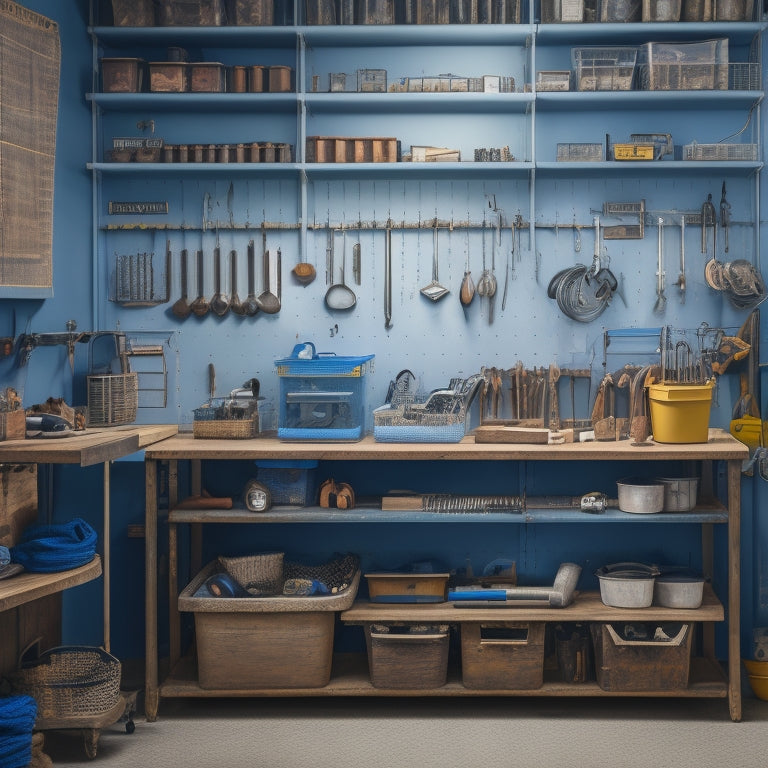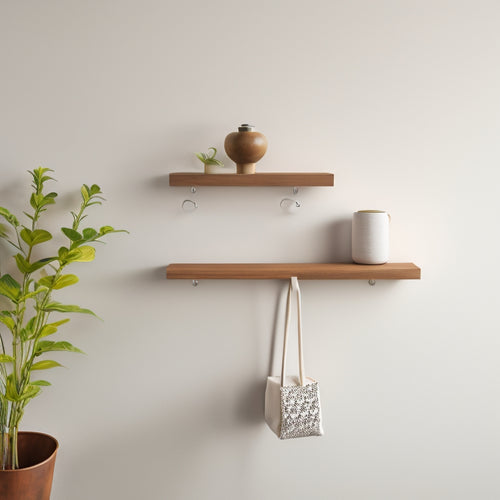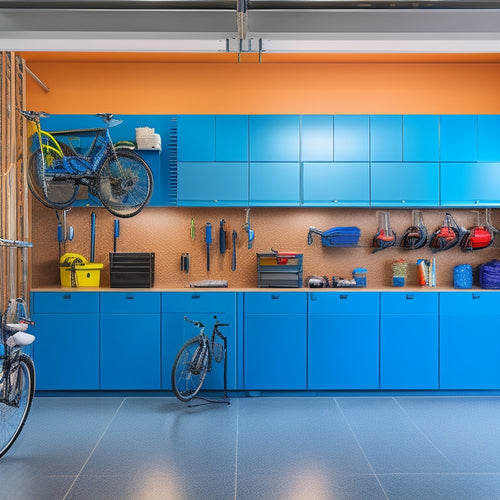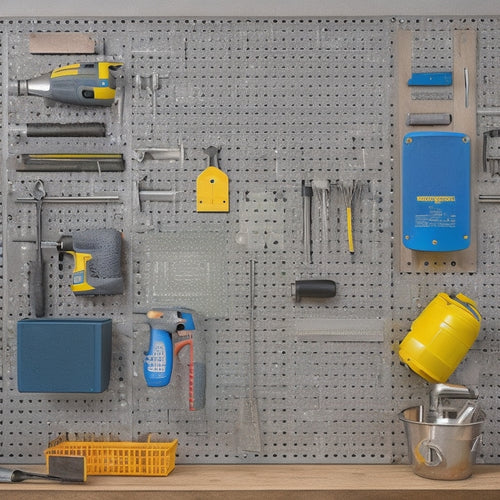
Optimize Your Workshop With Custom Tool Storage Solutions
Share
You can transform your workshop into a highly efficient and organized space by implementing custom tool storage solutions that cater to your specific needs and workflow. Start by decluttering your space and evaluating your tool storage needs. Custom solutions can maximize workshop efficiency, reduce tool loss, and increase tool lifespan. By designing a dream workshop layout, you can make the most of your space. Maximize vertical storage capacity, utilize hidden storage spaces, and create a pegboard system to keep tools organized. Implement a maintenance routine to keep your workshop running smoothly. Now, take the next step to creating a workshop that works for you.
Key Takeaways
• Implement custom storage solutions to maximize workshop efficiency, reduce tool loss, and enhance organization.
• Categorize tools by frequency of use, size, and weight to optimize storage and accessibility.
• Utilize hidden storage spaces, pegboard systems, and drawer systems to minimize clutter and save space.
• Designate a home for each tool and implement a maintenance routine to extend tool lifespan and reduce downtime.
• Group similar tools together and use dividers, compartments, and labels for quick identification and easy access.
Declutter Your Workshop Space
Clear out everything from your workshop space and sort items into three piles: keep, donate/sell, and discard, to get a realistic picture of what you need to store and what you can get rid of. This vital step in workshop decluttering will help you identify what's essential and what's taking up valuable space.
Be honest with yourself – if you haven't used it in the past year, it's probably safe to let it go. Once you've purged your unwanted items, it's time to focus on space optimization. Think about your workflow and how you can organize your tools and materials to maximize efficiency.
Consider installing shelving or cabinets to keep frequently used items within easy reach. Implementing these organization strategies will help you make the most of your workshop space, allowing you to work more effectively and efficiently.
Assessing Your Tool Storage Needs
Now that you've decluttered your workshop space, it's time to assess your tool storage needs.
Start by taking stock of your tools and equipment - what do you have, and how often do you use each item?
This inventory analysis will help you identify your current storage challenges and pinpoint areas for improvement.
Tool Inventory Analysis
Your tool collection's diversity and growth rate dictate the complexity of your storage needs, making a thorough tool inventory analysis essential to determining the most effective storage solutions. This analysis will help you identify areas for improvement in your current storage setup and provide a solid foundation for designing a custom storage system that meets your unique needs.
To conduct a tool inventory analysis, start by categorizing your tools into groups, such as hand tools, power tools, and accessories. Then, assess the frequency of use, size, and weight of each tool to determine its storage requirements.
| Tool Category | Storage Considerations |
|---|---|
| Hand tools | Inventory tracking, tool security |
| Power tools | Space optimization, accessibility |
| Accessories | Organization, easy retrieval |
Current Storage Challenges
Frequently, you're left digging through cluttered workbenches or cramped storage spaces to find the one tool you need, wasting precious time and energy. This is a common issue many workshop owners face, and recognizing the current storage challenges is crucial to optimize your workspace.
Here are some common scenarios you might relate to:
-
Tools scattered everywhere: You've got wrenches on the floor, screwdrivers on the workbench, and pliers on the shelf, making it challenging to find what you need quickly.
-
Cluttered workbenches: Your workbenches are filled with tools, materials, and half-finished projects, leaving little space to work efficiently.
-
Disorganized storage spaces: Your storage areas are crowded, and tools are stacked randomly, making it difficult to access the tools you need.
- Lost or misplaced tools: You've wasted time searching for a specific tool, only to realize it's been misplaced or lost in the chaos.
Benefits of Custom Storage Solutions
When you invest in a custom tool storage solution, you'll start to notice significant benefits that impact your daily workflow.
By maximizing your workshop's efficiency, you'll save time and energy that would've been wasted searching for misplaced tools.
With a customized storage system, you'll also reduce tool loss, which can lead to costly replacements and project delays.
Maximize Workshop Efficiency
By integrating custom tool storage solutions into your workshop, you can streamline your workflow, reduce downtime, and increase overall productivity. A well-organized workshop is essential for serving your clients efficiently and effectively.
With custom storage solutions, you can:
-
Access tools quickly: No more wasting time searching for misplaced tools or supplies.
-
Reduce clutter: Keep your workspace clean and organized, reducing the risk of accidents and improving focus.
-
Increase tool lifespan: Protect your tools from damage and wear, extending their lifespan and reducing replacement costs.
- Improve team collaboration: Clearly labeled storage solutions enable team members to find what they need, promoting a more collaborative and efficient work environment.
Reduce Tool Loss
Your custom storage solutions can greatly reduce the chances of tool loss, saving you the frustration and expense of replacing essential equipment. By implementing a well-organized tool storage system, you'll be able to keep track of your tools and materials, ensuring that everything has its designated place. This, in turn, will prevent tools from getting misplaced, lost, or stolen.
Effective tool organization is key to reducing tool loss. With custom storage solutions, you can create a system that allows you to categorize and store your tools in a logical and accessible manner. This will enable you to quickly locate the tools you need, reducing downtime and increasing productivity. Additionally, custom storage solutions will help you maintain accurate inventory management, allowing you to keep track of your tools and materials. By doing so, you'll be able to identify when it's time to restock or replace tools, ensuring that you always have what you need to get the job done.
With custom tool storage solutions, you'll be able to work more efficiently, reducing the risk of tool loss and the associated costs.
Designing Your Dream Workshop Layout
You'll need to evaluate your workshop's dimensions, door and window locations, and any obstacles to determine the best layout for your tools and workstations. Effective workshop layout optimization is essential for maximizing space utilization and boosting productivity.
To create your dream workshop layout, consider the following key elements:
-
Workstations:
Position them near power sources and away from foot traffic to minimize distractions. -
Tool zones:
Designate areas for specific tools, like a drill press station or a hand tool area, to streamline your workflow. -
Material storage:
Place storage bins and shelves near workstations to reduce walking distances and increase efficiency.
-
Aisleways:
Make sure there's enough space between workstations and storage areas for easy movement and access.
Maximizing Vertical Storage Capacity
Since floor space is often at a premium in workshops, maximizing vertical storage capacity is essential to keep your tools and materials within easy reach. You can achieve this by installing vertical shelving units that go up to the ceiling, making the most of your wall space.
Tool racks can be mounted on these shelves, allowing you to store frequently used tools in a compact and organized manner.
Hanging storage solutions are another effective way to maximize vertical storage capacity. You can install hooks, bins, or baskets on the walls or ceiling to store items like extension cords, hoses, or accessories. This not only frees up floor space but also keeps your workshop organized and clutter-free.
Consider incorporating a drawer system into your workshop design. This will provide you with additional storage for smaller items like fasteners, nuts, and bolts.
Tool Organization for Efficiency
With your tools and materials now neatly stored, it's time to focus on organizing them in a way that streamlines your workflow and saves you time. Effective tool organization techniques are essential to achieving efficiency in your workshop. By implementing the right storage solutions, you'll be able to quickly find what you need, reducing downtime and increasing productivity.
Here are some efficiency tips to keep in mind:
-
Group similar tools together: Store tools of the same type, such as all your screwdrivers or wrenches, in close proximity to minimize walking distances and reduce searching time.
-
Designate a home for each tool: Assign a specific spot for each tool, making it easy to find and return it after use.
-
Use dividers and compartments: Separate tools within a storage unit using dividers or compartments to prevent clutter and confusion.
- Label everything: Clearly label each storage unit, compartment, and tool to make sure you can quickly identify what's inside.
Creating a Pegboard System
By installing a pegboard system, you can maximize your workshop's vertical storage space and keep frequently used tools within easy reach, freeing up valuable floor and bench space for other tasks. A well-planned pegboard organization system can make a significant difference in your workshop's efficiency.
Start by determining the types of tools you need to store and the frequency of use. This will help you decide on the layout and design of your pegboard. Choose custom hangers and storage baskets that fit your specific tool display needs. For example, you can use metal hooks for hanging wrenches and pliers, while small storage baskets can hold screws, nails, and other small parts.
Label each hook and basket so you can easily identify what's stored there. Consider adding a pegboard above your workbench or along a wall to create a convenient tool display area. With a pegboard system, you'll be able to quickly find the tools you need, saving you time and increasing your productivity.
Utilizing Hidden Storage Spaces
You can uncover valuable storage space in your workshop by looking beyond the obvious areas and exploiting hidden spots that are often overlooked. By thinking creatively, you can turn these secret compartments into functional storage solutions.
For instance:
-
Under-shelf storage: Install sliding drawers or trays underneath your workbench or shelves to stash small items like screws, nuts, or bolts.
-
Hidden cabinets: Design cabinets with secret compartments or sliding panels to conceal valuable tools or materials.
-
False bottoms: Create false bottoms in your tool chests or drawers to hide valuable items or sensitive equipment.
- Wall-mounted storage: Utilize the space between wall studs to create hidden drawers or shelves for storing items like levels, pliers, or wrenches.
These creative solutions will help you maximize your workshop's storage capacity, keeping your tools and materials organized and within reach.
Implementing a Maintenance Routine
Now that you've optimized your workshop's storage capacity, it's time to focus on implementing a maintenance routine to guarantee your tools and equipment remain in top condition. A well-maintained workshop ensures you can work efficiently and effectively, serving your clients to the best of your abilities.
Start by incorporating weekly tool checks into your routine. Set aside 30 minutes each week to inspect your tools, checking for signs of wear and tear, and performing minor repairs or replacements as needed. This proactive approach will prevent tool failures and reduce downtime.
Develop an organizing system for your tools and equipment, making it easy to locate and access what you need when you need it. This will also help you identify any tools that are missing or need to be replaced.
Frequently Asked Questions
Can I DIY Custom Tool Storage Solutions or Do I Need a Professional?
You can try DIY options like repurposing crates or building shelves, but if you're short on time or need complex solutions, consider hiring professional services to design and install custom tool storage solutions that meet your specific needs.
How Do I Prioritize Which Tools to Store in Easy-To-Access Locations?
Did you know 80% of workshop time is spent searching for tools? You prioritize tools for easy access by categorizing them by frequency of use, grouping similar tools together, and placing them in intuitive locations, ensuring efficient tool organization and workspace optimization.
Are Custom Storage Solutions Expensive and Worth the Investment?
You're wondering if custom storage solutions are pricey and worth the investment. While they may seem costly upfront, they're cost-effective in the long run, offering quality, organization, and long-term benefits that'll save you time and hassle.
Can Custom Tool Storage Solutions Be Adapted for Small Workshops?
You can adapt custom tool storage solutions for small workshops by exploring space-saving options and modular designs that maximize vertical storage, allowing you to efficiently organize tools and supplies in even the tightest spaces.
How Do I Ensure Custom Storage Solutions Are Flexible for Future Changes?
You might worry that custom storage solutions won't adapt to future changes, but you can future-proof your storage by opting for adaptable designs, flexibility in customization, and scalability, ensuring your workshop remains organized and efficient.
Related Posts
-

Wall Mounted Hooks With Shelf for Maximum Storage
You'll find that wall mounted hooks with a shelf are a revolutionary solution for maximizing storage in your home, pr...
-

Top Garage Storage Bins for Organization and Style
You can enhance your garage's style and organization with the right storage bins. Top brands like Rubbermaid, Suncast...
-

How to Hang a Pegboard in 5 Easy Steps
You'll hang a pegboard in 5 easy steps by first preparing the wall, ensuring it's sturdy and free of obstructions. Ne...


